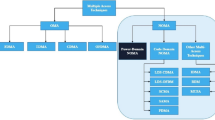Abstract
The NOMA (non-orthogonal multiple access) techniques developed in the context of 5G networks allows several users to share the same frequency band simultaneously. The main problem posed by this approach is the existence of interferences between the signals from different users. This article proposes a novel decoder model based on two successive interference cancellation operations in parallel. The first one cancels interferences successively in increasing direction of the powers while the second one cancels in decreasing direction. The simulation of network performances with the proposed decoding algorithm allows us to observe a clear improvement of the performances with regards to the standard approach of cancellation in descending order of powers. The simulation results indicate a significant improvement in network performances of more than 35% in terms of throughput, energy efficiency and spectral efficiency compared to the standard approach. Finally, we established by calculations and confirmed by simulations the existence of an optimum transmission power of the base station which allows maximization of the energy efficiency. Newton's method has been applied to find this optimal transmission power.


















Similar content being viewed by others
References
Dai, L., Wang, B., Ding, Z., Wang, Z., Chen, S., & Hanzo, L. (2018). A survey of non-orthogonal multiple access for 5G. IEEE Communications Surveys & Tutorials, 20(3), 2294–2323. https://doi.org/10.1109/COMST.2018.2835558
Kumar, A., Kumar, K., Gupta, M. S., & Kumar, S. (2020). A survey on NOMA techniques for 5G scenario. SSRN Electronic Journal. https://doi.org/10.2139/ssrn.3573579
Islam, S. M. R., Avazov, N., Dobre, O. A., & Kwak, K. (2017). Power-domain non-orthogonal multiple access (NOMA) in 5G systems: potentials and challenges. IEEE Communications Surveys & Tutorials, 19(2), 721–742. https://doi.org/10.1109/COMST.2016.2621116
Kizilirmak, R. C. (2016). Non-orthogonal multiple access (NOMA) for 5G networks. In H. K. Bizaki (Ed.), Towards 5G wireless networks - a physical layer perspective. InTech. https://doi.org/10.5772/66048
Ghaffari, A., Leonardon, M., Cassagne, A., Leroux, C., & Savaria, Y. (2019). Toward high-performance implementation of 5G SCMA algorithms. IEEE Access, 7, 10402–10414. https://doi.org/10.1109/ACCESS.2019.2891597
Balasubramanya, N. M., Gupta, A., & Sellathurai, M. (2018). Combining code-domain and power-domain NOMA for supporting higher number of users. In 2018 IEEE Global Communications Conference (GLOBECOM) (pp. 1–6). Abu Dhabi, United Arab Emirates: IEEE. https://doi.org/10.1109/GLOCOM.2018.8647770
Al Rabee, F. T., & Gitlin, R. D. (2020). Uplink power-domain non-orthogonal multiple access (NOMA): Bit Error rate performance with channel estimation errors. International Journal of Interdisciplinary Telecommunications and Networking, 12(4), 65–73. https://doi.org/10.4018/IJITN.2020100105
Cai, Y., Qin, Z., Cui, F., Li, G. Y., & McCann, J. A. (2018). Modulation and multiple access for 5G networks. IEEE Communications Surveys & Tutorials, 20(1), 629–646. https://doi.org/10.1109/COMST.2017.2766698
Sadia, H., Zeeshan, M., & Sheikh, S. A. (2018). Performance analysis of downlink power domain NOMA under fading channels. In 2018 ELEKTRO (pp. 1–6). Mikulov: IEEE. https://doi.org/10.1109/ELEKTRO.2018.8398247
Li, H., He, W., He, Q., & He, J. (2017). The application and development of SIC technology in wireless communication system. In 2017 IEEE 9th International Conference on Communication Software and Networks (ICCSN) (pp. 565–570). Guangzhou: IEEE. https://doi.org/10.1109/ICCSN.2017.8230175
Andrawes, A., Nordin, R., & Abdullah, N. F. (2019). Energy-efficient downlink for non-orthogonal multiple access with SWIPT under constrained throughput. Energies, 13(1), 107. https://doi.org/10.3390/en13010107
Ramesh, P., & Bhuvaneswari, P. T. V. (2022). Non orthogonal multiple access requirements for 5G and its myths. In 2022 IEEE Delhi Section Conference (DELCON) (pp. 1–6). New Delhi, India: IEEE. https://doi.org/10.1109/DELCON54057.2022.9752790
Marzook, A., Mohammed, H., & Roomi, H. (2020). Performance of non-orthogonal multiple access (NOMA) with successive interference cancellation (SIC). Iraqi Journal for Electrical and Electronic Engineering, sceeer, 3, 152–156. https://doi.org/10.37917/ijeee.sceeer.3rd.21
Ozduran, V. (2019). Inverse successive interference cancellation for non-orthogonal multiple access. In 2019 27th Telecommunications Forum (TELFOR) (pp. 1–4). Belgrade, Serbia: IEEE. https://doi.org/10.1109/TELFOR48224.2019.8971091
Akbar, A., Jangsher, S., & Bhatti, F. A. (2021). NOMA and 5G emerging technologies: a survey on issues and solution techniques. Computer Networks, 190, 107950. https://doi.org/10.1016/j.comnet.2021.107950
Ding, Z., Lei, X., Karagiannidis, G. K., Schober, R., Yuan, J., & Bhargava, V. K. (2017). A survey on non-orthogonal multiple access for 5G networks: research challenges and future trends. IEEE Journal on Selected Areas in Communications, 35(10), 2181–2195. https://doi.org/10.1109/JSAC.2017.2725519
Araujo, D. C., Lucena, A. M. P., & Moura Mota, J. C. (2014). Successive interference cancellation algorithm in m-QAM nonorthogonal multicarrier systems. In 2014 International Telecommunications Symposium (ITS) (pp. 1–5). Sao Paulo: IEEE. https://doi.org/10.1109/ITS.2014.6948049
Selvam, K., & Kumar, K. (2019). On sum- throughput and fairness index analysis of downlink NOMA over OFDMA for machine -to -machine communication. IJARCCE, 8(5), 73–80. https://doi.org/10.17148/IJARCCE.2019.8516
Argyros, I. K., & González, D. (2016). Newton’s method for convex optimization. In S. Amat & S. Busquier (Eds.), Advances in iterative methods for nonlinear equations (pp. 23–56). Cham: Springer International Publishing.
Acknowledgements
The authors thank Mr. Daniel Eutyche Mbadjoun Wapet for his assistance with formatting issues of the manuscript, Mrs. Charlotte Ngoula Madjo and Mr. Pascal Yvon Mayang Fokou for language revision.
Author information
Authors and Affiliations
Corresponding author
Additional information
Publisher's Note
Springer Nature remains neutral with regard to jurisdictional claims in published maps and institutional affiliations.
Rights and permissions
Springer Nature or its licensor holds exclusive rights to this article under a publishing agreement with the author(s) or other rightsholder(s); author self-archiving of the accepted manuscript version of this article is solely governed by the terms of such publishing agreement and applicable law.
About this article
Cite this article
Talla, B.C.K., Bossou, O.V., Feudjio, C. et al. A new approach of successive interference cancellation decoder in power domain non-orthogonal multiple access transmission. Wireless Netw 29, 509–521 (2023). https://doi.org/10.1007/s11276-022-03136-0
Accepted:
Published:
Issue Date:
DOI: https://doi.org/10.1007/s11276-022-03136-0




